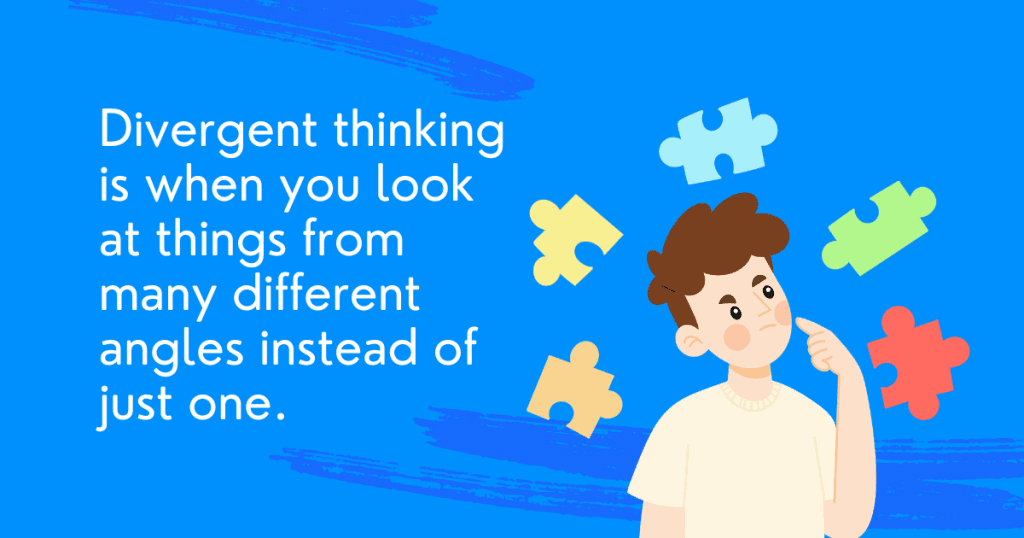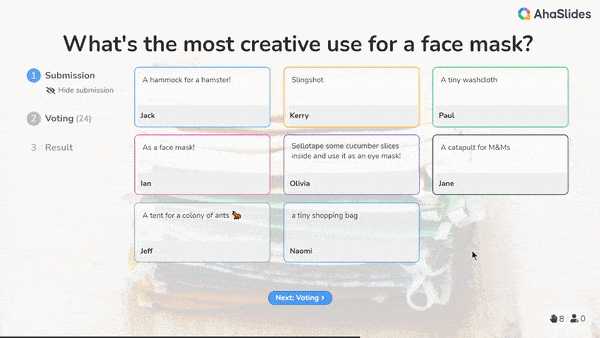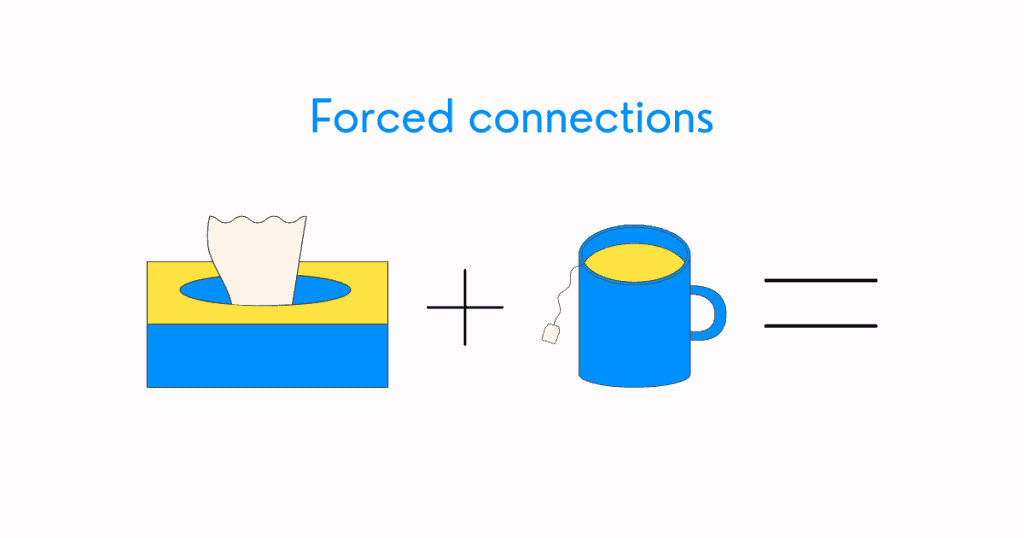Have you ever come up with different ways to solve a math problem instead of following what the teacher has taught?
Have you ever thought of all the possible uses for an item, like using socks to clean window blinds?
If the answer is yes, you probably are a divergent thinker!💭
But, what is divergent thinking exactly and how can it help you navigate through complex problems? Find out this concept in this article.
Table of Contents
- What is Divergent Thinking?
- Divergent Thinking Examples
- Divergent Thinking Exercises and Techniques
- Key Takeaways
- Frequently Asked Questions

Looking for More Fun During Gatherings?
Gather your team members by a fun quiz on AhaSlides. Sign up to take free quiz from AhaSlides template library!
🚀 Grab Free Quiz☁️
What is Divergent Thinking?
Divergent thinking is when you look at things from many different angles instead of just one.
Divergent thinking encourages imagination and curiosity. It allows you to freely associate one concept or idea with another to make novel links.
Even seemingly unrelated things can spark new insights when viewed through a diverse lens.

Rather than critiquing each new idea, divergent thinking postpones judgment. It's a process of exploration without censorship of whatever your mind generates.
Later the ideas can be refined, but initially, anything goes to stimulate as much cognitive and conceptual variety as possible.
It tends to arise through questions rather than statements. Asking "what if" helps divergence by opening up alternatives rather than prematurely narrowing options down. Hypothetical scenarios also fuel more creative possibilities.
💡 See also: Convergent vs Divergent Thinking.Divergent Thinking Examples
Divergent thinking is an essential skill for design, problem-solving, innovation and fluid, flexible response in complex environments. Let's see some examples of daily situations in which you can harness this valuable skill👇
• Brainstorming uses of an object: Coming up with many different potential uses for a common household item, like a brick🧱️, beyond its typical functions. Examples could include using it as a doorstop, paperweight, textbook prop, and such.
• Ideating new possibilities: Picking a common thing and coming up with different ways to improve it, such as instead of presenting your talk one-way and leaving the discussion till the end, you organise ice-breaker activities at the beginning like a small quiz, Q&A and polls to enliven the crowd.Turn presentations into interactive experiences
Make your presentations more engaging, more memorable, and more effective with AhaSlides.

Here's an example of a fairytale retelling of The Wolf and the Seven Young Goats using a more modern and metaphorical approach. A must-watch short clip that's worth your time!
• Name new types of businesses: Thinking up novel business ideas by combining unrelated categories like "yoga studio for cats" or "food truck that delivers results". You can somehow end up tapping into the market niche, so don't shush your ideas away even if they are insane.• Improvising uses for objects: Acting out spontaneous scenarios of plausible but creative repurposing roles for items not traditionally designed for that, such as using a bottle of wine as a dough roller.• Question posing: Generating queries that expand the dimensions of an issue rather than narrowing in on set answers, for instance, "What if education was personalised and not age-based?", or "How can I make this task faster?"Divergent Thinking Exercises and Techniques
#1. Brainstorming
Brainstorming is an effective activity to generate novel responses.
In this activity, you or your team will come up with as many ideas/solutions as possible within a time limit without passing judgment.
You can use AhaSlides' brainstorming feature to jot down thoughts, questions and ideas in response to prompts and pass your responses to others to build on ideas anonymously. This helps avoid bias.

💡 Brainstorm ideas properly using this compact guide.
#2. Mind Mapping

Mind mapping is another strategy to inspire divergent thinking.
You'll visually map connections from a central topic by branching out ideas without hierarchy. Seeing relationships among them can help spark new links.
Plotting concepts spatially allows flexible linking that linear lists don't, as colour/images enhance cognition and you can focus more on the output by starting in the centre.
💡 See also: 6 Steps to Create Mind Map.#3. Forced Connections

Using this technique helps build abstract thought and analogy skills.
You practice forced connections by picking two random words and looking for relationships, like "tree-smartphone" to exercise imaginative analogies.
Pushing relationships between random items is challenging and forces thinking in entirely different domains.
You can see this often happens between seemingly unrelated industries, like utilising artificial intelligence in agriculture to forecast and minimise the risk of crop failures.
💡 See also: Lateral Thinking Puzzles to Encourage Creative Thinking.#4. Hypothetical Scenarios

You can imagine future scenarios by varying descriptive details and unpredictably changing circumstances over time to create new plot angles.
It keeps the analytic left brain engaged in problem-solving versus just listing abstract notions.
Hypothetical scenarios can be seen in NGOs to envision alternative ways of addressing future crises and being more proactive, or utilised by urban designers to model potential outcomes of variable city development plans.
#5. Ideas Ladder

You start with an initial idea/concept and then build upon it by suggesting modifications or adjustments to progressively diverge the initial concept.
If it's done in a group, one person states an opening idea and then each subsequent person elaborates on it or takes it in an unexpected direction, with no idea too minor or strange.
For example: "Book" -> "Ebook" -> "Ebook that reads itself aloud" -> "Ebook pet that reads and interacts" -> "Library of living storytelling pets to borrow".
The concept is to encourage fluid, emergent ideas where one suggestion leads to another in an organic chain.
Key Takeaways
Divergent thinking is a useful type of thinking that facilitates creative problem-solving and innovation.
After all, learning to think in wider and more flexible ways can only lead to greater progress. So explore ideas freely, make unusual connections, and let your mind wander to its heart's content - that is the spirit of true divergent thought.
Frequently Asked Questions
What are the 4 principles of divergent thinking?
The four primary principles that underly divergent thought are: deferring judgment, seeking quantity, building on ideas, and striving for novelty.
What is a divergent way of thinking?
A divergent way of thinking involves exploring multiple possibilities or solutions rather than focusing on a single answer.
What is divergent and convergent thinking?
Divergent and convergent thinking are two cognitive processes crucial for problem-solving and creativity. Divergent thinking creates multiple diverse ideas, exploring unconventional solutions, while convergent thinking narrows options to find the best solution.








